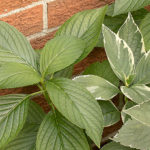Plant reversions

The first time I saw a plant reversion, I wasn’t sure what I was looking at. A customer had called and said there was a TREE growing out of her Dwarf Alberta Spruce. I had never seen this before, so I had to get my Dad involved. He said it was a classic! One of the buds one year cast off the dwarfing gene and the regular white spruce began to grow instead. I have to admit it was pretty cool looking - the white spruce growing straight and tall - but the customer wasn’t thrilled. The reversion is always more vigorous and would eventually take over the plant if not addressed.

Dwarf Alberta Spruce with reverting growth
Many of the most interesting and unique plants in the trade come from a spontaneous mutation, like a witch's broom or a variegated sprout. The mutation is discovered, a cutting is taken, and the variety eventually propagated and introduced. Some of these mutations aren’t that stable, and you will see parts of or entire plants reverting to the original form. I would like to point out that this is different than when the rootstock takes over a grafted plant, in that case you can see the growth is coming from below the graft.

Weigela 'My Monet' losing the variegation on a few branches
Reversion can be brought on by many factors, but environmental stress seems to be a common cause. If you are observant when you are out on landscapes, you can see reversions all the time. That spruce example happens now and again, and loss of variegation is another one that’s fairly easy to find.

Cornus alba 'Elegantissima' going green
So getting back to my “Classic” scenario, my Dad suggested to our customer that we should prune it out immediately, as it was only going to get worse. There was a good chance the plant would survive and eventually fill in around the removed portion. If we didn’t, the reversion would dominate, and the resulting tree was never going to be an attractive specimen. I’m a tree hugger and my Dad’s even worse so of course we recommended trying to save the tree. In the end, we replaced the plant - because of its location and visibility the recovery time was unacceptable.

Hydrangea macrophylla 'Mariesii Variegata' not playing nice
Each case is a judgement call. If you catch it while the reverted growth is fairly small, a simple pruning may be sufficient to eliminate it. Perennials such as hosta can be dug up, split, and replanted.

Hosta 'Christmas Tree' not so festive
So be on the lookout for reversions. They are kind of cool, sometimes a little weird but definitely more common than you think. Take some pictures, share with us what you are finding and I will pull together a follow up discussion on this topic. Remember: Prune out all you can to “nip it in the bud” - if it’s too late replace it - and get a picture for our discussion.
